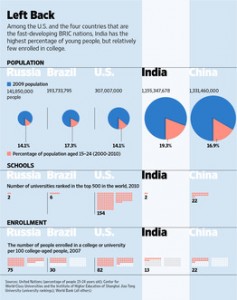Call-center company 24/7 Customer Pvt. Ltd. is desperate to find new recruits who can answer questions by phone and email. It wants to hire 3,000 people this year. Yet in this country of 1.2 billion people, that is beginning to look like an impossible goal.
So few of the high school and college graduates who come through the door can communicate effectively in English, and so many lack a grasp of educational basics such as reading comprehension, that the company can hire just three out of every 100 applicants.
India projects an image of a nation churning out hundreds of thousands of students every year who are well educated, a looming threat to the better-paid middle-class workers of the West. Their abilities in math have been cited by President Barack Obama as a reason why the U.S. is facing competitive challenges.
Yet 24/7 Customer’s experience tells a very different story. Its increasing difficulty finding competent employees in India has forced the company to expand its search to the Philippines and Nicaragua. Most of its 8,000 employees are now based outside of India.
In the nation that made offshoring a household word, 24/7 finds itself so short of talent that it is having to offshore.
“With India’s population size, it should be so much easier to find employees,” says S. Nagarajan, founder of the company. “Instead, we’re scouring every nook and cranny.”
India’s economic expansion was supposed to create opportunities for millions to rise out of poverty, get an education and land good jobs. But as India liberalized its economy starting in 1991 after decades of socialism, it failed to reform its heavily regulated education system.
Business executives say schools are hampered by overbearing bureaucracy and a focus on rote learning rather than critical thinking and comprehension. Government keeps tuition low, which makes schools accessible to more students, but also keeps teacher salaries and budgets low. What’s more, say educators and business leaders, the curriculum in most places is outdated and disconnected from the real world.
“If you pay peanuts, you get monkeys,” says Vijay Thadani, chief executive of New Delhi-based NIIT Ltd. India, a recruitment firm that also runs job-training programs for college graduates lacking the skills to land good jobs.
Muddying the picture is that on the surface, India appears to have met the demand for more educated workers with a quantum leap in graduates. Engineering colleges in India now have seats for 1.5 million students, nearly four times the 390,000 available in 2000, according to the National Association of Software and Services Companies, a trade group.
But 75% of technical graduates and more than 85% of general graduates are unemployable by India’s high-growth global industries, including information technology and call centers, according to results from assessment tests administered by the group.
Another survey, conducted annually by Pratham, a nongovernmental organization that aims to improve education for the poor, looked at grade-school performance at 13,000 schools across India. It found that about half of the country’s fifth graders can’t read at a second-grade level.
At stake is India’s ability to sustain growth
